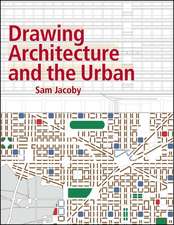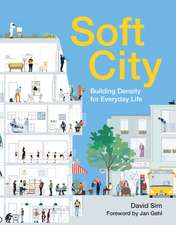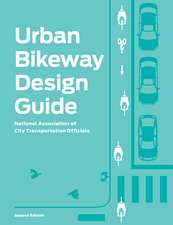The Architecture of Community
Autor Leon Krieren Limba Engleză Paperback – 16 mar 2011
Leon Krier is one of the best-known—and most provocative—architects and urban theoreticians in the world. Until now, however, his ideas have circulated mostly among a professional audience of architects, city planners, and academics. In The Architecture of Community, Krier has reconsidered and expanded writing from his 1998 book Architecture: Choice or Fate. Here he refines and updates his thinking on the making of sustainable, humane, and attractive villages, towns, and cities. The book includes drawings, diagrams, and photographs of his built works, which have not been widely seen until now.
With three new chapters, The Architecture of Community provides a contemporary road map for designing or completing today’s fragmented communities. Illustrated throughout with Krier’s original drawings, The Architecture of Community explains his theories on classical and vernacular urbanism and architecture, while providing practical design guidelines for creating livable towns.
The book contains descriptions and images of the author’s built and unbuilt projects, including the Krier House and Tower in Seaside, Florida, as well as the town of Poundbury in England. Commissioned by the Prince of Wales in 1988, Krier’s design for Poundbury in Dorset has become a reference model for ecological planning and building that can meet contemporary needs.
With three new chapters, The Architecture of Community provides a contemporary road map for designing or completing today’s fragmented communities. Illustrated throughout with Krier’s original drawings, The Architecture of Community explains his theories on classical and vernacular urbanism and architecture, while providing practical design guidelines for creating livable towns.
The book contains descriptions and images of the author’s built and unbuilt projects, including the Krier House and Tower in Seaside, Florida, as well as the town of Poundbury in England. Commissioned by the Prince of Wales in 1988, Krier’s design for Poundbury in Dorset has become a reference model for ecological planning and building that can meet contemporary needs.
Preț: 435.65 lei
Nou
Puncte Express: 653
Preț estimativ în valută:
83.38€ • 85.93$ • 70.40£
83.38€ • 85.93$ • 70.40£
Carte disponibilă
Livrare economică 11-25 februarie
Preluare comenzi: 021 569.72.76
Specificații
ISBN-13: 9781597265799
ISBN-10: 1597265799
Pagini: 496
Ilustrații: extensively illustrated illustrations
Dimensiuni: 159 x 254 x 33 mm
Greutate: 1.06 kg
Ediția:None
Editura: Island Press
Colecția Island Press
ISBN-10: 1597265799
Pagini: 496
Ilustrații: extensively illustrated illustrations
Dimensiuni: 159 x 254 x 33 mm
Greutate: 1.06 kg
Ediția:None
Editura: Island Press
Colecția Island Press
Notă biografică
Born in 1946, Leon Krier is one of the most influential architects teaching and writing today. He has taught architecture and urbanism at the Royal College of Arts in London, and in the United States at Princeton University, Yale University, the University of Notre Dame, and the University of Virginia. He has worked extensively in Europe and North America and is currently consulting on projects in Guatemala, Romania, England, Belgium, Italy, France, and the United States. In 2003, he received the inaugural Richard Driehaus Prize for Classical Architecture.
Cuprins
Author's Note
Foreword \ Robert A. M. Stern
Preface: The Art of Making Places
PART I. Aspects of Modernity
Chapter 1. Introduction
Chapter 2. Contemporary Prospects
Chapter 3. From Political Pluralism to Architectural Plurality
Chapter 4. The Authority of the Architect in a Democracy
Chapter 5. Toward a Coexistence of Doctrines
Chapter 6. The Architect's Categorical Imperative
PART II. Nature of the Architectural Object
Chapter 1. Res Publica • Res Privita
Chapter 2. Nameable Objects and So-called Objects
Chapter 3. Definition of the Architectural Object
Chapter 4. True and False Monuments
Chapter 5. Technology and Architectural Expression
Chapter 6. Summary of Terms and Concepts
-modernity • modernism • tradition
-typology • type • composition
-invention • innovation • discovery
-Traditional architecture: vernacular building and classical architecture
-Region and style
PART III. Critique of a Modernist Ideology
Chapter 1. "How to Make the Easy Difficult by Way of the Useless"
Chapter 2. Modernism and the Anticonformism of the Establishment
Chapter 3. Historicism and Modernism
Chapter 4. Modernism and Progress
Chapter 5. The Aporia of Modernism
Chapter 6. Modernism and Experimentalism
Chapter 7. Modernism and Functionalism
Chapter 8. Modernism and Formalism
Chapter 9. Zeitgeist
Chapter 10. Modernism and Memory
Chapter 11. Modernism and Conservation: The Charter of Venice and Docomomo
Chapter 12. After Modernism
Chapter 13. Gained in Translation
PART IV. Prospects for a New Urbanism
Chapter 1. Forms of Urban Overexpansion
Chatper 2. Ecology and Urbanism • The Vital Link
Chapter 3. Critique of Industrial Planning and Functional Zoning
Chapter 4. The Urbanization of the Suburbs
-New areas for urban development and the internal growth of cities
Chapter 5. The Need to Reform Development Programs
Chapter 6. The Masterplan, a Definition
Chapter 7. The Masterplan, a Tool of Public Interest
PART V. The Polycentric City of Urban Communities
Chapter 1. Cities within the City Structural Components
-urban quarter • borough • city • metropolis
Chatper 2. City and Landscape Sustainability
Chapter 3. Structure and Form of the Urban Quarter
-size • plan • skyline
Chapter 4. Geometry of Urban Patterns
Chapter 5. Siting of Buildings on Squares, Streets, and Blocks
Chapter 6.Type, Shape, and Character of Urban Spaces
Chapter 7. Single-lot Blocks • Multi-lot Blocks and their Architecture
Chapter 8. Hierarchy of Public Spaces and Circulation Hierarchy
Chapter 9. The Polycentric Zoning of Functions
Chapter 10. Building Heights
Chapter 11. In Praise of Towers
Chapter 12. Critical Problems of Plot-ratios
Chapter 13. Artificial Lighting of Public Spaces
PART VI. Washington DC: An Unfinished Canvas
Chapter 1. Washington DC, a Global Ecological Reconstruction
Chapter 2. Rebirth of the American City
Chapter 3. On Classical Architecture and Vernacular Building
PART VII. The Modernity of Traditional Architecture
Chapter 1. Traditional Culture and the Idea of Progress
Chapter 2. Architecture and Politics
Chapter 3. Whe Architecture Matters to You!
Chapter 4. The Destiny of Traditional Architecture
Chapter 5. The Perennial Values of the Principles of Traditional Architecture
Chapter 6. The New • The Unique • The Tectonic • The Original
Chapter 7. Natural and Synthetic Materials
Chapter 8. Venustas • Firmitas • Utilitas
PART VIII. Universal Usefulness of Modern Craft Industry or the Fourth Industrial Revolution
Chapter 1. Critique of the Industrialization of Buildings
Chapter 2. The Evaluation of Buildings by their Whole Life Cycle
Chapter 3. Knowledge of Know-how: The Need for Modern Craftsmanship
PART IX. The Architectural Tuning of Settlements
Chapter 1. The Architectural Tuning of Settlements
PART X. Drawing to Reality
Chapter 1. Why I Practice Classical Architecture and Traditional Urbanism
Chapter 2. Sculpture Podium, Barcelona, Spain
Chapter 3. Tower Block Renovation, Alessandria, Italy
Chapter 4. Archeological Museum, Sintra, Portugal
Chapter 5. The Seaside Prize
Chapter 6. Robert Davis Laudatio
Chapter 7. Krier House, Seaside, Florida, USA
Chapter 8. Città Nuova, Alessandria, Italy
Chapter 9. Windsor Village Hall, Vero Beach, Florida, USA
Chapter 10. Brasserie Agape, Val D'Europe, France
Chapter 11. The Jorge M. Perez Architectural Center, University of Miami, Coral Gables, Florida, USA
Chapter 12. The Richard H. Driehaus Prize for Classical Architecture
Chapter 13. Jaque Robertson Laudatio
Chapter 14. Hameau-des-Pins, Hardelot, France
Chapter 15. Poundbury, Dorchester, Dorset, UK
Afterwords
Conclusion
The Last Word \ James Howard Kuntsler
Index
Photo Credits
Author's Biography
Other Publications
Editors' Biographies
Foreword \ Robert A. M. Stern
Preface: The Art of Making Places
PART I. Aspects of Modernity
Chapter 1. Introduction
Chapter 2. Contemporary Prospects
Chapter 3. From Political Pluralism to Architectural Plurality
Chapter 4. The Authority of the Architect in a Democracy
Chapter 5. Toward a Coexistence of Doctrines
Chapter 6. The Architect's Categorical Imperative
PART II. Nature of the Architectural Object
Chapter 1. Res Publica • Res Privita
Chapter 2. Nameable Objects and So-called Objects
Chapter 3. Definition of the Architectural Object
Chapter 4. True and False Monuments
Chapter 5. Technology and Architectural Expression
Chapter 6. Summary of Terms and Concepts
-modernity • modernism • tradition
-typology • type • composition
-invention • innovation • discovery
-Traditional architecture: vernacular building and classical architecture
-Region and style
PART III. Critique of a Modernist Ideology
Chapter 1. "How to Make the Easy Difficult by Way of the Useless"
Chapter 2. Modernism and the Anticonformism of the Establishment
Chapter 3. Historicism and Modernism
Chapter 4. Modernism and Progress
Chapter 5. The Aporia of Modernism
Chapter 6. Modernism and Experimentalism
Chapter 7. Modernism and Functionalism
Chapter 8. Modernism and Formalism
Chapter 9. Zeitgeist
Chapter 10. Modernism and Memory
Chapter 11. Modernism and Conservation: The Charter of Venice and Docomomo
Chapter 12. After Modernism
Chapter 13. Gained in Translation
PART IV. Prospects for a New Urbanism
Chapter 1. Forms of Urban Overexpansion
Chatper 2. Ecology and Urbanism • The Vital Link
Chapter 3. Critique of Industrial Planning and Functional Zoning
Chapter 4. The Urbanization of the Suburbs
-New areas for urban development and the internal growth of cities
Chapter 5. The Need to Reform Development Programs
Chapter 6. The Masterplan, a Definition
Chapter 7. The Masterplan, a Tool of Public Interest
PART V. The Polycentric City of Urban Communities
Chapter 1. Cities within the City Structural Components
-urban quarter • borough • city • metropolis
Chatper 2. City and Landscape Sustainability
Chapter 3. Structure and Form of the Urban Quarter
-size • plan • skyline
Chapter 4. Geometry of Urban Patterns
Chapter 5. Siting of Buildings on Squares, Streets, and Blocks
Chapter 6.Type, Shape, and Character of Urban Spaces
Chapter 7. Single-lot Blocks • Multi-lot Blocks and their Architecture
Chapter 8. Hierarchy of Public Spaces and Circulation Hierarchy
Chapter 9. The Polycentric Zoning of Functions
Chapter 10. Building Heights
Chapter 11. In Praise of Towers
Chapter 12. Critical Problems of Plot-ratios
Chapter 13. Artificial Lighting of Public Spaces
PART VI. Washington DC: An Unfinished Canvas
Chapter 1. Washington DC, a Global Ecological Reconstruction
Chapter 2. Rebirth of the American City
Chapter 3. On Classical Architecture and Vernacular Building
PART VII. The Modernity of Traditional Architecture
Chapter 1. Traditional Culture and the Idea of Progress
Chapter 2. Architecture and Politics
Chapter 3. Whe Architecture Matters to You!
Chapter 4. The Destiny of Traditional Architecture
Chapter 5. The Perennial Values of the Principles of Traditional Architecture
Chapter 6. The New • The Unique • The Tectonic • The Original
Chapter 7. Natural and Synthetic Materials
Chapter 8. Venustas • Firmitas • Utilitas
PART VIII. Universal Usefulness of Modern Craft Industry or the Fourth Industrial Revolution
Chapter 1. Critique of the Industrialization of Buildings
Chapter 2. The Evaluation of Buildings by their Whole Life Cycle
Chapter 3. Knowledge of Know-how: The Need for Modern Craftsmanship
PART IX. The Architectural Tuning of Settlements
Chapter 1. The Architectural Tuning of Settlements
PART X. Drawing to Reality
Chapter 1. Why I Practice Classical Architecture and Traditional Urbanism
Chapter 2. Sculpture Podium, Barcelona, Spain
Chapter 3. Tower Block Renovation, Alessandria, Italy
Chapter 4. Archeological Museum, Sintra, Portugal
Chapter 5. The Seaside Prize
Chapter 6. Robert Davis Laudatio
Chapter 7. Krier House, Seaside, Florida, USA
Chapter 8. Città Nuova, Alessandria, Italy
Chapter 9. Windsor Village Hall, Vero Beach, Florida, USA
Chapter 10. Brasserie Agape, Val D'Europe, France
Chapter 11. The Jorge M. Perez Architectural Center, University of Miami, Coral Gables, Florida, USA
Chapter 12. The Richard H. Driehaus Prize for Classical Architecture
Chapter 13. Jaque Robertson Laudatio
Chapter 14. Hameau-des-Pins, Hardelot, France
Chapter 15. Poundbury, Dorchester, Dorset, UK
Afterwords
Conclusion
The Last Word \ James Howard Kuntsler
Index
Photo Credits
Author's Biography
Other Publications
Editors' Biographies
Recenzii
"More than ever Krier has every right to claim our attention. We need him, in fact, as never before. He presents us with the lessons, if we would but take them, that come out of rediscovery. He celebrates the values that are knowable."
"This book is Mr. Krier's gift to the coming generations-who, otherwise, have been left saddled by us with little more than extravagant debts in every way you could imagine. They are going to have to inhabit what remains of this planet, along with whatever remains of its resources, when we are gone, and Mr. Krier's heroic, often lonely labors, have produced this indispensable beacon of principle and methodology to light their way home."
"This is the compendium of common sense that has flowed from Leon's pen for over forty years. From first to last, none of it has aged; and none of it will age. It is the one indispensable book on urbanism."
"Long the inspiration of new urbanists, Léon Krier's work, now comprehensively gathered in this book, is still the best guide for designing buildings and communities."
"Leon Krier's The Architecture of Community is a primer on the fundamentals of the language of architecture and urbanism...Krier's childlike drawings, distilled captions and hornbook like aphorisms make this the perfect textbook with which to begin reclaiming our lost literacy."
"One of the most influential architects and urban theoreticians of the modern age, Krier has a clear idea of what's wrong with many of our urban development patterns—and he has a similarly clear idea about how those problems can be avoided in the future. His book is a collection of suggestions and proposals that make up a general theory for how to create traditional cities, towns and communities that are attractive, livable, and (hopefully) truly loved."
"This book provides detailed drawings and images to illustrate the author's theories on classical urbanism and architecture, while providing practical guidelines for creating attractive, livable towns. The book also outlines a diagnosis and a cure, a critique and a project, and presents a common-sense approach to urban planning."
Descriere
Leon Krier is one of the best-known—and most provocative—architects and urban theoreticians in the world. Until now, however, his ideas have circulated mostly among a professional audience of architects, city planners, and academics. In The Architecture of Community, Krier has reconsidered and expanded writing from his 1998 book Architecture: Choice or Fate. Here he refines and updates his thinking on the making of sustainable, humane, and attractive villages, towns, and cities. The book includes drawings, diagrams, and photographs of his built works, which have not been widely seen until now.












